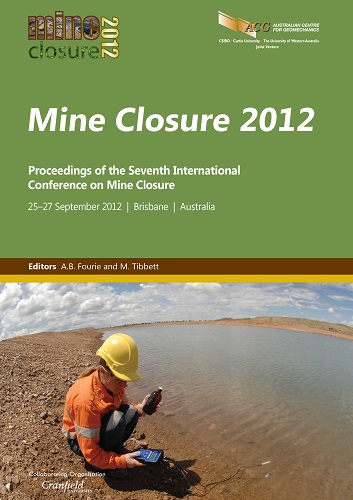Effective social planning for mine closure

|
Authors: Lamb, K; Coakes, S |
DOI https://doi.org/10.36487/ACG_rep/1208_53_Lamb
Cite As:
Lamb, K & Coakes, S 2012, 'Effective social planning for mine closure', in AB Fourie & M Tibbett (eds), Mine Closure 2012: Proceedings of the Seventh International Conference on Mine Closure, Australian Centre for Geomechanics, Perth, pp. 627-639, https://doi.org/10.36487/ACG_rep/1208_53_Lamb
Abstract:
Most Australian resource companies recognise that effective community engagement enhances their corporate reputation and underpins their social licence to operate. Industry-leading companies also understand that the socio-economic impacts of their operations need to be assessed and managed with the same rigour as environmental, health and safety impacts. Some companies, however, fail to see the value of robust community engagement or socio-economic impact assessment during mine closure planning. A robust approach to mine closure planning considers community impacts and relevant mitigation strategies in both the lead-up to mine closure and during mine closure – in fact, some would advocate that consideration of the social aspects of closure should be undertaken from the inception of a project or operation. This paper will demonstrate a best-practice approach to assessing the socio-economic impacts of mine closure, and will outline how to engage with communities during this time of uncertainty. Through discussion of a range of practical case studies, a suite of tools will be highlighted that can be used at an operational level to assess the status of key community assets and capitals and in determining a community’s sustainability when facing closure of a nearby mine. Such tools include: Community Sensitivity Analysis (Coakes and Sadler, 2011), Town Resource Cluster Analysis (Fenton et al., 2003) Stakeholder Mapping and Community Needs Assessment. In addition, effective management strategies to prepare communities for mine closure will be explored and recommended approaches to community engagement during each phase of mine closure discussed. Mine closures can afford genuine opportunities for communities when companies are proactive, diligent, and comprehensive in their planning approach. This paper will demonstrate how companies can work with communities to leave a positive legacy and genuinely support a community’s sustainability long after a mining operation is gone.
References:
Beckley, T., Nadeau, S., Wall, E. and Martz, D. (2002) Multiple capacities, multiple outcomes: delving deeper into the meaning of community capacity, Paper presented at the Annual Meeting of the Rural Sociological Society, August 14–17, Congress Plaza Hotel, Chicago, IL.
Coakes, S. (2009a) Victoria's forestry communities: adapting to change in the forestry industries, Report prepared for Department of Primary Industries, Melbourne, Victoria.
Coakes, S. (2009b) Pilbara Coast TRC case study, Report prepared for Department of Climate Change, Perth, Western Australia.
Coakes, S. and Sadler, A. (2011) Utilizing a sustainable livelihoods approach to inform a social impact assessment practice, F. Vanclay and A.M. Esteves (eds), New Directions in Social Impact Assessment, Edward Elgar, UK.
DFID (1999) Department for International Development, Sustainable livelihoods guidance sheets, London.
DITR (2006) Department of Industry Tourism and Resources, Mine closure and completion: leading practice sustainable development program for the mining industry.
Ellis, F. (2000) Rural livelihoods and diversity in developing countries, Oxford University Press, England.
Fenton, M., Coakes, S. and Marshall, N. (2003) Vulnerability and capacity measurement, in The International Handbook of Social Impact Assessment, H. Becker and F. Vanclay (eds), Cheltenham, UK, Edward Elgar Publishing, pp. 211–230.
Hart, M. (1999) Guide to sustainable community indicators, Ipswich, MA, QLF/Atlantic Centre for the Environment.
ICMM (2008) International Council of Mining and Metals. Planning for integrated mine closure toolkit, London.
International Organization for Standardization (2011) ISO 26000 – Social responsibility.
MCA (2004) Minerals Council of Australia. Enduring value – the Australian miners industry framework for sustainable development, Minerals Council of Australia, Canberra.
Vanclay, F. (2003) International principles for social impact assessment, Impact Assessment and Project Appraisal, Vol. 21, pp. 5–11.
© Copyright 2026, Australian Centre for Geomechanics (ACG), The University of Western Australia. All rights reserved.
View copyright/legal information
Please direct any queries or error reports to repository-acg@uwa.edu.au
View copyright/legal information
Please direct any queries or error reports to repository-acg@uwa.edu.au